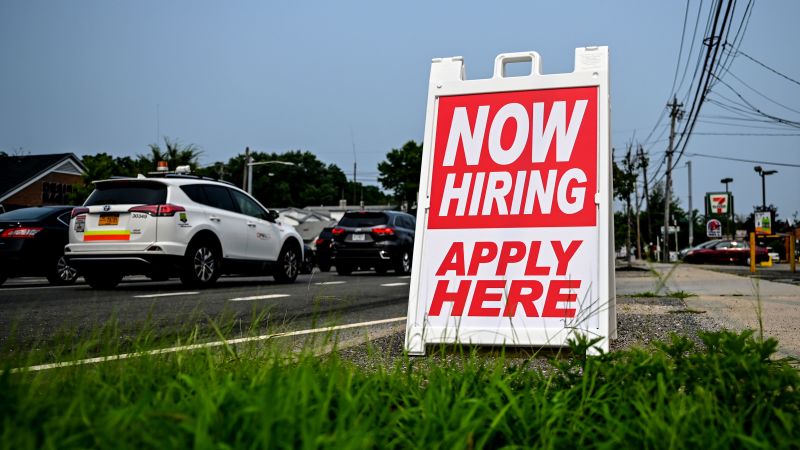Washington
CNN
—
In President Donald Trump’s volatile trade war, the Federal Reserve may face the difficult choice of saving jobs or fighting inflation. But if push comes to shove, the central bank would likely prioritize the labor market.
The Fed is tasked by Congress to safeguard the job market and wrangle inflation — its so-called dual mandate — primarily using interest rates to achieve those goals.
In most instances, it’s clear which side of the Fed’s dual mandate needs attention. For example, the Fed lowered interest rates to stimulate the economy in the throes of the Great Recession in 2008, when job losses were rampant. And when inflation was running at 40-year highs in 2022, the Fed aggressively raised interest rates to cool the economy and stem price pressures.
Now, the central bank is confronting a challenge it hasn’t seen in decades: Its dual objectives are simultaneously under threat as Trump’s punishing tariffs threaten to drive both unemployment and inflation higher. The president’s tit-for-tat trade war is already weighing on American businesses and consumers.
The Fed on Wednesday held rates steady for the third time in a row, waiting for Trump’s policies to show up more clearly in economic data. But the central bank’s latest policy statement noted that the risk of higher unemployment and higher inflation has risen.
At a news conference that same day, Fed Chair Jerome Powell reiterated that stagflation — the combination of stagnant growth and higher inflation — would put the central bank in a difficult situation.
But Fed officials, including Powell on Wednesday, have hinted that they’ll respond quickly to any whiff of a weakening labor market, as they did last year, even if there’s a tariff-induced rise in inflation.
“When the Fed starts to see the unemployment rate rise and nonfarm payrolls start to crack, they’re going to prioritize the employment side,” Nicole Cervi, an economist at Wells Fargo, told CNN.
Fed officials have said there’s good reason to believe any inflation induced by tariffs might be temporary.
“Inflation could rise starting in a few months and then move back down toward our target possibly as early as by the end of this year. Yes, I am saying that I expect that elevated inflation would be temporary,” Christopher Waller, who is on the Fed’s Board of Governors, said on April 14 at an event in St. Louis, Missouri.
But even if inflation rises only temporarily, “the effects on output and employment could be longer-lasting and an important factor in determining the appropriate stance of monetary policy,” he said.
But St. Louis Fed President Alberto Musalem warned in a speech in late March that the Fed should be “wary of assuming that the impact of tariff increases on inflation will be entirely temporary.”
Inflation could stick around and become a bigger problem if people lose faith that price increases will go back to normal or if there are supply-chain disruptions.
However, a weakening job market could very well undo upward pressure on prices.
“Any sign of growing slack in the jobs market would give the Fed some reassurance that inflationary pressures will subside, and give them room to offer more support to the economy with rate cuts,” James Knightley, chief international economist at ING, told CNN.
In April, the US economy added a stronger-than-expected 177,000 jobs as the unemployment rate held steady at a low 4.2%. But hiring trends could change, as recession fears and high levels of economic uncertainty loom.
“Many firms (in the Boston Fed’s district) planned to pause or limit hiring going forward because of policy uncertainty,” according to the central bank’s latest Beige Book report, a periodic collection of survey responses from businesses across the country.
Trump’s tariffs have already weighed on economic growth. Gross domestic product, which measures all the goods and services produced in the economy, fell in the beginning of the year in its first quarterly decline since 2022. Americans had rushed to buy products ahead of the tariffs, sending imports surging and far outpacing exports.
Last year, the Fed showed it’s highly sensitive to a weakening labor market.
In September, the central bank delivered a bold half-point cut after unemployment climbed for a few months and employers downshifted job growth. It turned out that the job market was just softening, but Fed officials still responded swiftly.
“The Fed surprised everyone with that 50 basis-point cut,” Cervi said. “Jerome Powell, in my opinion, is a bit more dovish than not, and we think that that that will likely prevail here.”
“Dovish” is a term that refers to when a Fed official is more concerned with preventing any undue damage to the economy or the labor market.
Powell, in Wednesday’s news conference, defended that jumbo rate cut, saying “it was a really obvious concern” at the time.
“The unemployment rate went up by almost a full percentage point, and it was click, click, click, click, click each month, and everywhere people were talking about downside risks to the labor market,” Powell said.
“We’ve been there for inflation for a couple of years and we wanted to show also that we’re there for the labor market, and it’s important that we sent that signal,” he said.

